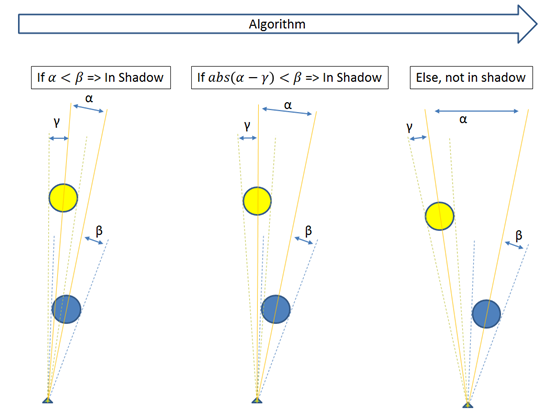Description
Determines the entry time, exit time, and duration of a Spacecraft's pass through the shadow of a CelestialObject specified by celestialObjectID.
The shadow times are determined using a conical shadow. The algorithm to determine the times a Spacecraft is in any portion of the occulting body is shown in the diagram below.

Algorithm used to determine if a Spacecraft is in the occulting body's shadow.
Note: This method uses a spherical model for the occulting body. Use the options available in the VisibilityCalculator to exercise more control over the analysis.
Timing Precision Mode
This page describes functionality in nanosecond timing precision mode.
Click here to see the documentation for this object in millisecond timing precision mode.
Note: This is an interval method. See the Interval Methods page for more information.
Note: This method has a state. See the Methods and Properties with State page for more information.
Method Signature
Spacecraft.ShadowTimes( |
Variable celestialObjectID) |
Arguments
celestialObjectID |
|||||||||||||||||||||||||||
Description: |
ID of the CelestialObject to use as the occulting body. Body ID's 1-11 are assigned to the default Solar System objects, as shown below. Custom CelestialObjects will have body ID's starting at 12 and assigned in the order they are created. |
||||||||||||||||||||||||||
Valid Values: |
|
Return Value
Type: |
string |
Returns a string containing the entry time, exit time, and duration of any passes through the shadow of the specified central body.
The FF_Preferences.IntervalEventReportingBehavior property controls whether the start and end of propagation are reported as events. By default, if the time in shadow starts before the beginning of the propagation span, FreeFlyer will label the start of the propagation as the start of the time in shadow. If the time in shadow extends past the end of the propagation span, FreeFlyer labels the end of propagation as the end of the time in shadow.
Syntax
myString1 = mySpacecraft1.ShadowTimes(myVariable1); |
This example demonstrates how to generate a report of a Spacecraft's passes through a CelestialObject's shadow.
Output:
Note: Output generated using nanosecond timing precision mode.
|
See also
Coverage and Contact Analysis Guide